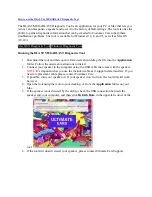
8
The value displayed on the frequency value field on the LCD display represents the instant output frequency and is updated on the LCD
display every 0.1s.
Use the
UP and DOWN
buttons to select the appropriate range of the sweep start frequency. The
FREQUENCY
knob is used to select
the sweep start frequency within a range (see
Table1
for range’s details).
The sweep is always done from the start frequency down to stop frequency, thus start frequency is always greater then the stop
frequency. The stop frequency can reach a maximum of 1:100 of start frequency (see subchapter 3.1.x for learning how to set the stop
frequency). The unit reaches the stop frequency after a time, which can be set between 0.01s and 30.00s, with 0.01s resolution (see
subchapter 3.1.y for learning how to set the time sweep).
Turning the
FREQUENCY
knob will force unit to display the sweep start frequency. Each time the sweep start frequency is modified,
either by pressing the
UP or DOWN
button or turning the
FREQUENCY
knob, the sweep will reinitialized and unit will start
outputting again from the start frequency.
ATTENTION
:
If stop frequency is under the current lower range limit, the frequency sweep will not stop at the range limit; the
instant frequencies will be displayed using the current range displaying rules.
3.1.2. Level setting (except FREQCOUNTER mode).
This section describes the setting of the signal level at the main output jack,
OUTPUT
jack.
Level can be set between 10mV
p-p
and 10.0V
p-p
(on 50
Ω
load), using 2 ranges. Pressing –20dB button will change the level range by
engaging/disengaging the –20dB attenuate on the signal path (see Table2 for details). The –20dB LED associated with the button will
light when the –20dB attenuate is engaged. Turning the
OUTPUT LEVEL
knob will change the level value within the current range.
Range Lowest
value Highest
value
Unit
Resolution -20dB
LED
1 10
1000
MV
1 Lighted
2 1.01
10.00
V
0.01
No
light
Level is displayed on the second line of the LCD display, using a 4-digit value field, followed by the unit. The decimal point is used
only for the upper range. On the right of the second line, the word “Output” will be displayed to identify that the level parameter has
changed. Since the second line is used for displaying other parameters when they are modified, the unit will display the output level
again automatically 7 seconds after the last parameter modification,
Note:
The level displayed on the LCD is considered a LOADED value which is the level that will appear across a 50
Ω
load connected
to the OUTPUT jack. If you are connecting the output to a high impedance load, the output voltage will be twice what is
entered.
3.1.3. Offset setting (except FREQCOUNTER mode).
This section describes the setting of the DC level added to the signal at the main output,
OUTPUT
jack.
Offset can be set between – 5.000 V and + 5.000 V (on 50
Ω
load), by turning the DC OFFSET knob and using 0.001V resolution (see
Table 3). The DC Offset LED associated to DC OFFSET knob will be lighted when the DC level added to the signal is not zero.
Range Lowest
value Highest
value Unit Resolution
1
- 5.000
+ 5.000
V
0.001
Offset is displayed on the second line of the LCD display using a sign digit and a 4-digit value field, followed by the measuring unit. On
the right of the second line the word “Offset will be displayed” to identify that the offset parameter has changed. Automatically, 7
seconds after the last change of the offset value, the unit will display the output level.
Note:
1.
The offset voltage specified is a 50
Ω
LOADED value. This is the voltage that will appear across a 50
Ω
load
connected to the OUTPUT jack. If the output is being connected to a high impedance load, the output voltage will
be twice what is entered.
2.
Care must be taken when specifying an output offset voltage and level such that the output does not clip. The loaded
output cannot swing higher than + 5.000 V or lower than – 5.000 V. Therefore:
Table2: Level ranges
Table 3: Offset range










































